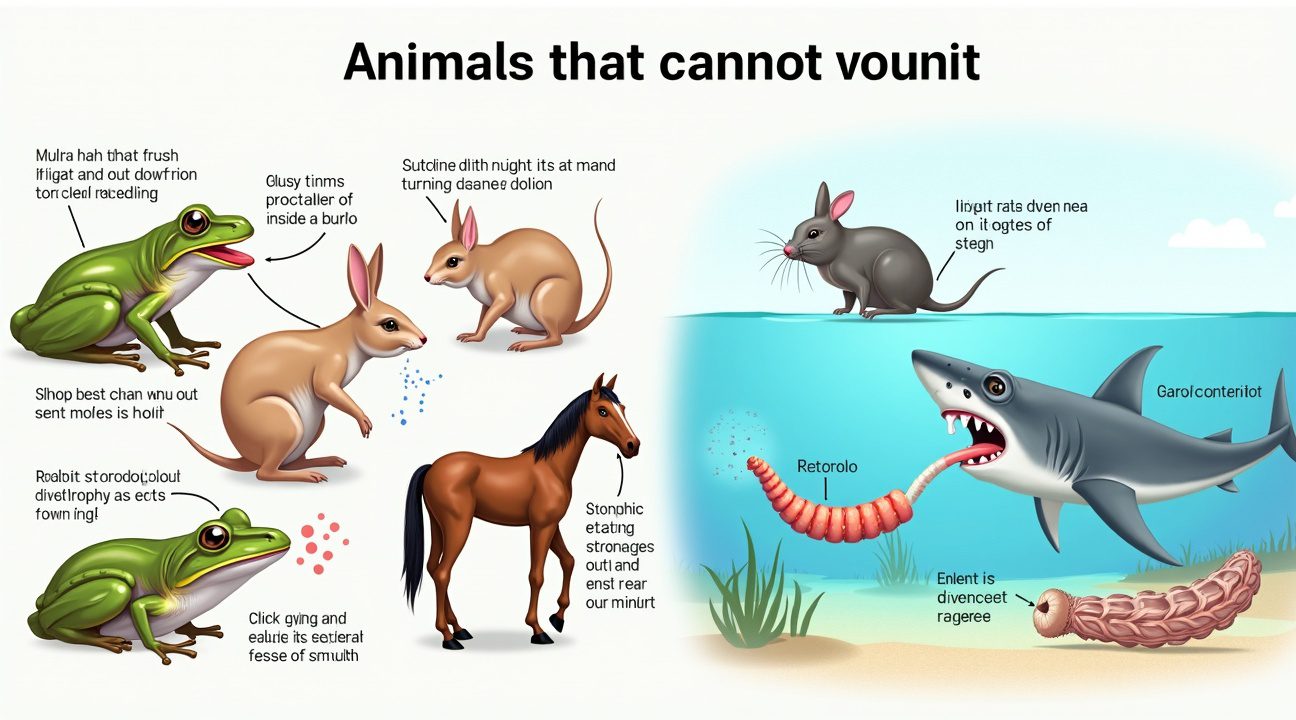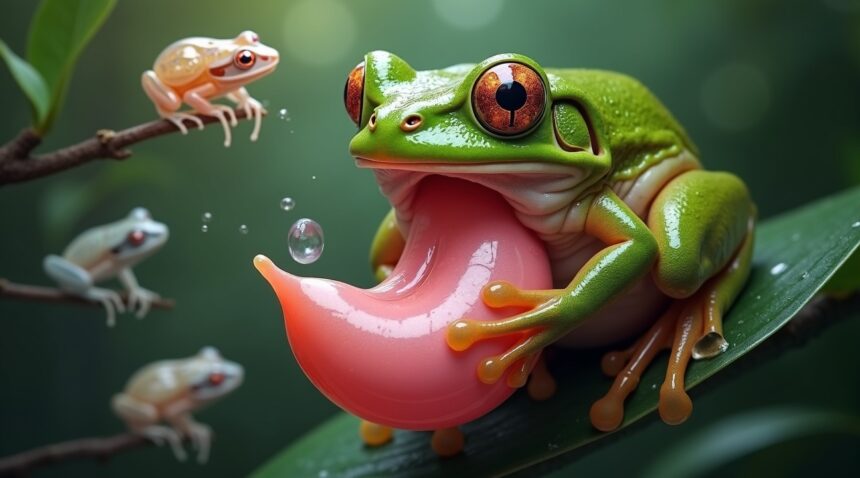When frogs consume poisonous or indigestible substances, they perform one of nature’s most extreme survival mechanisms called full gastric eversion, literally forcing their entire stomach outside their body through their mouth. This dramatic process allows the amphibian to manually clean the everted stomach with their front legs before carefully pulling it back inside, providing a complete solution to digestive emergencies that other animals cannot achieve.
Key Takeaways
- Complete stomach ejection: Frogs turn their entire stomach inside out and expel it through their mouth as a pink, balloon-like sac when they ingest harmful substances.
- Manual cleaning process: Using their front legs as tools, frogs physically scrub and wipe the exterior surface of their everted stomach to remove all toxic residue and indigestible particles.
- Evolutionary adaptation: This mechanism evolved because frogs lack the anatomical structures needed for conventional vomiting, making gastric eversion their primary defense against poisonous ingestion.
- Vulnerable but effective: While the process leaves frogs temporarily exposed to predators and environmental risks, it provides superior contamination removal compared to standard regurgitation.
- Shared limitation: Frogs join other animals like horses, rabbits, and rats that cannot vomit through normal means, though frogs developed the most dramatic solution to this digestive challenge.
The Ultimate Stomach Ejection: How Frogs Literally Turn Themselves Inside Out
I’ve witnessed some incredible survival mechanisms in nature, but few compare to what frogs do when they consume something harmful. Unlike humans who can simply vomit to expel dangerous substances, frogs take a far more dramatic approach through a process called full gastric eversion.
When a frog ingests something poisonous or completely indigestible, it doesn’t just regurgitate the contents of its stomach. Instead, the amphibian literally forces its entire stomach organ outside through its mouth, creating what looks like a pink balloon protruding from its face. This isn’t partial ejection – the whole stomach gets turned completely inside out and expelled from the body.
A Survival Mechanism Born from Anatomical Limitations
Frogs evolved this extraordinary ability because they lack the anatomical structures that allow mammals to vomit effectively. Their digestive system simply doesn’t support the muscular contractions and coordination required for typical regurgitation. Full gastric eversion became their solution to a potentially deadly problem.
During this process, I can observe several distinct phases:
- The frog recognizes the toxic or indigestible material in its stomach
- Specialized muscles contract to force the stomach through the esophagus and out the mouth
- The everted stomach appears as a glistening, pink sac hanging outside the frog’s body
- The frog uses its front legs to manually clean the stomach surface, removing all harmful substances
- Once thoroughly cleaned, the stomach gets pulled back inside and repositioned
This cleaning phase proves particularly fascinating because the frog actively scrapes and wipes the exterior surface of its everted stomach with its front limbs. I find it remarkable that amphibians can perform such precise manual manipulation while maintaining the stomach’s integrity outside their body.
The entire stomach ejection and retrieval process typically takes several minutes to complete. Frogs demonstrate incredible control during this vulnerable period, managing to retract their cleaned stomach without damage or contamination. This adaptation has proven so effective that multiple frog species across different families have developed this capability independently.
Scientists have documented this behavior in various frog species when they encounter everything from toxic insects to inedible debris. The mechanism works so efficiently that frogs can survive ingesting substances that would prove fatal to animals without this ability. Nature’s deadliest creatures often inspire such remarkable defensive adaptations.
Full gastric eversion represents one of nature’s most extreme solutions to digestive emergencies, showcasing how amphibians have evolved creative workarounds for their anatomical constraints.
The Bizarre Cleaning Ritual: Frogs Manually Scrub Their Own Stomachs
Once the stomach hangs outside the frog’s body, an extraordinary cleaning process begins that looks almost mechanical in its precision. I find this aspect of gastric eversion particularly fascinating because the frog treats its stomach like any external object that needs scrubbing clean.
The Physical Cleaning Process
The frog’s front legs become specialized cleaning tools during this critical phase. These limbs methodically wipe across the exposed stomach surface, removing any toxic residue, indigestible particles, or contaminating substances that triggered the ejection response. Each sweeping motion helps eliminate dangerous materials that could cause further harm if allowed to remain in the digestive system.
The frog continues this wiping action until the stomach appears clean of all unwanted debris. This hands-on approach differs dramatically from how mammals handle similar situations. While humans experience nausea and vomiting to expel harmful substances, frogs must physically manipulate their stomach tissue to achieve the same protective outcome.
This cleaning ritual represents a direct intervention method that allows frogs to address digestive threats immediately. The exposed stomach provides complete access for thorough decontamination, something impossible with internal stomach positioning. Each cleaning motion removes potential toxins that could continue causing damage if left untreated.
The process resembles behaviors seen in deadly creatures that have evolved specific survival mechanisms. Just as other animals develop unique protective strategies, frogs have perfected this stomach-cleaning technique through evolutionary pressure.
This adaptation carries both advantages and significant risks:
- Advantages: The cleaning efficiency surpasses what internal muscular contractions could achieve, allowing frogs to consume a wider variety of prey without permanent digestive damage.
- Risks: The exposed stomach becomes vulnerable to environmental contamination, predator attacks, and potential injury during the cleaning process.
The contrast with mammalian nausea highlights different evolutionary solutions to the same problem. While mammals rely on muscular reflexes to expel stomach contents, frogs have developed this external cleaning system that provides superior contamination removal. This approach allows them to recover from encounters with dangerous species that might otherwise prove fatal.
After completing the cleaning ritual, the frog carefully guides the stomach back into its body cavity. This reinsertion process requires precise coordination to ensure proper positioning and function restoration. The entire sequence demonstrates remarkable evolutionary engineering that enables frogs to survive in environments where toxic encounters occur regularly.
Animals That Can’t Throw Up: The Surprising Company Frogs Keep
Frogs aren’t alone in their inability to vomit through conventional means. Several other animals share this limitation, though each species has developed unique strategies to handle toxic or indigestible substances. Horses, rabbits, and rats all lack the physiological ability to throw up, leaving them vulnerable when they consume harmful materials.
Species Without Standard Vomiting Mechanisms
These animals face significant challenges when dealing with poisonous substances:
- Horses cannot vomit due to their specialized digestive anatomy, making them particularly susceptible to colic and other digestive complications.
- Rabbits rely on their selective eating habits and cecotrophy (eating special soft feces) to manage their nutritional needs.
- Rats compensate for their inability to vomit through highly developed taste and smell senses that help them avoid toxic foods.
Extraordinary Gastric Solutions in Marine Life
Some marine creatures have evolved even more dramatic solutions than frogs. Sharks can perform complete gastric eversion, turning their stomachs inside out and ejecting them through their mouths to expel irritating contents. This process mirrors what frogs do but occurs in an aquatic environment where the cleaning process differs significantly.
Sea cucumbers take defensive ejection to an extreme level through autotomy. When threatened, these creatures deliberately eject their intestines as a distraction mechanism, allowing them to escape predators. Unlike frogs’ stomach cleaning behavior, this represents a defensive strategy where the undiscovered species sacrifices part of their body temporarily.
The comparison reveals fascinating adaptations across different animal groups. While frogs manually clean their everted stomachs before retracting them, sharks simply flush out irritants in water. Sea cucumbers use their ejection ability primarily for defense rather than digestive maintenance. Each species has evolved specific responses based on their environment and survival needs.
Understanding these diverse approaches to digestive challenges highlights how evolution produces varied solutions to similar problems. Frogs’ stomach ejection represents just one strategy among many that animals use when conventional vomiting isn’t possible. These adaptations demonstrate the remarkable ways different species handle the universal challenge of consuming potentially harmful substances.

See-Through Stomachs: Glass Frogs and Other Transparent Wonders
The extraordinary ability to eject and clean stomachs becomes even more fascinating when I consider species with transparent anatomy. Japanese tree frogs demonstrate this remarkable defensive mechanism, but their biology reveals additional adaptations that showcase the intricate design of amphibian physiology.
Glass frogs represent one of nature’s most captivating examples of transparency in vertebrates. These remarkable creatures inhabit the Neotropics, where approximately 157 species display varying degrees of translucent skin that allows direct observation of their internal anatomy. When I examine a glass frog, the stomach, heart, liver, and other vital organs become clearly visible through their transparent undersides, creating a living window into amphibian biology.
This transparency serves multiple evolutionary purposes beyond mere curiosity. The see-through quality helps glass frogs blend seamlessly with their leafy environments, making them nearly invisible to predators when positioned on translucent leaves. Their transparent skin acts as natural camouflage, similar to how ancient forest ecosystems create complex hiding places for various species.
Observing Internal Processes Through Transparent Skin
The transparent anatomy of glass frogs provides unprecedented insight into the stomach ejection process. Scientists can actually watch the entire digestive system in action, including the dramatic moment when these amphibians expel their stomachs in response to toxic substances. This visibility eliminates guesswork about internal mechanisms that remain hidden in opaque species.
Several key advantages emerge from studying transparent amphibians:
- Real-time observation of digestive processes without invasive procedures
- Better understanding of how toxins affect internal organs
- Direct visualization of the stomach cleaning and retraction process
- Enhanced knowledge of amphibian adaptation strategies
The Japanese tree frog combines stomach ejection capabilities with semi-transparent features, though not to the extent seen in true glass frogs. This species demonstrates how different amphibian lineages have developed similar protective mechanisms while maintaining distinct anatomical characteristics. Research on these frogs reveals that transparency doesn’t compromise their ability to perform complex biological functions like stomach eversion.
Transparent skin in amphibians requires specific cellular arrangements that maintain structural integrity while allowing light penetration. The skin contains specialized cells called iridophores that can be manipulated to increase or decrease transparency. During periods of stress or when ejecting stomach contents, these cells may alter their configuration, potentially affecting the visibility of internal processes.
Glass frogs face unique challenges related to their transparency. Their exposed organs become more vulnerable to environmental stressors, yet they’ve developed compensatory mechanisms that protect vital systems. The stomach ejection ability serves as an additional safeguard, allowing these frogs to quickly eliminate threats that could damage their visible internal structures.
Different glass frog species exhibit varying levels of transparency, with some displaying completely clear abdomens while others show partial translucency. This variation suggests that transparency evolved as a gradient rather than an all-or-nothing adaptation. Species living in areas with higher predation pressure often develop more complete transparency, while those in safer environments may retain some opacity.
The study of transparent amphibians continues to reveal new insights about vertebrate biology and evolution. Unlike the mysterious nature of deep-sea creatures that remain largely hidden from view, glass frogs offer researchers an open book for understanding complex physiological processes. Their transparent anatomy combined with remarkable defensive behaviors like stomach ejection represents millions of years of evolutionary refinement, demonstrating how amphibians continue to adapt and survive in challenging environments.
The Eyeball Eating Method: How Frogs Use Their Eyes to Swallow Food
Frogs possess one of nature’s most unusual feeding mechanisms, employing their prominent eyeballs as essential tools for swallowing prey. I find this adaptation fascinating because it demonstrates how evolution creates unexpected solutions to common biological challenges.
The Mechanics of Eye-Assisted Swallowing
When a frog captures food, it doesn’t simply use its tongue and throat muscles like most animals. Instead, the amphibian retracts its eyeballs downward into its mouth cavity, creating additional pressure to push food down its throat. This process involves the frog literally pushing its bulging eyes down through the roof of its mouth, compressing the oral cavity and forcing prey toward the esophagus.
The BBC documented this extraordinary feeding adaptation, particularly noting its prevalence in species such as the monkey frog. This mechanism works because frogs lack the ability to chew their food, making efficient swallowing critical for survival. The eyeballs act as biological pistons, generating the necessary force to move large prey items through the digestive tract.
Evolutionary Advantages and Species Variations
This eye-assisted feeding strategy offers several advantages that help explain its persistence across amphibian species. The method allows frogs to consume prey items that might otherwise be too large for their throat capacity, expanding their dietary options significantly. Additionally, the rapid swallowing technique reduces the time spent vulnerable during feeding, which proves crucial when predators threaten.
Different frog species have refined this technique to varying degrees. Some amphibians can retract their eyes completely during swallowing, while others use partial eye movements to assist with smaller prey. The efficiency of this system becomes particularly evident when observing frogs attempt to consume challenging items – their eyes work overtime to process difficult meals.
This unique feeding adaptation connects to broader amphibian survival strategies, much like how other creatures have evolved remarkable defensive mechanisms. Just as deadly birds have developed specialized hunting techniques, frogs have perfected their own distinct feeding approach.
The relationship between eye positioning and swallowing efficiency highlights the interconnected nature of amphibian anatomy. Frogs’ prominent, forward-facing eyes serve dual purposes – providing excellent vision for hunting and functioning as mechanical aids during consumption. This dual functionality exemplifies evolutionary efficiency, where single anatomical features serve multiple critical functions.
Scientists continue studying this feeding mechanism to understand its full implications for amphibian digestion and survival. The research reveals how seemingly simple feeding behaviors actually involve complex muscular coordination and anatomical adaptations. These discoveries contribute to broader understanding of vertebrate feeding strategies and evolutionary biology, similar to how researchers explore other fascinating biological phenomena like dinosaur DNA recreation or investigate undiscovered species in remote locations.
The eyeball eating method represents just one aspect of amphibian feeding complexity. Combined with their ability to eject and clean their stomachs when necessary, frogs demonstrate remarkable digestive flexibility. This combination of unusual feeding mechanisms and emergency digestive responses showcases the sophisticated survival strategies that have enabled amphibians to thrive across diverse environments for millions of years.
Sources:
HowStuffWorks: “Frogs Can’t Vomit, So They Eject Their Entire Stomachs”
Grunge: “Frogs Throw Up Their Entire Stomach Rather Than Just The Contents Of It”


